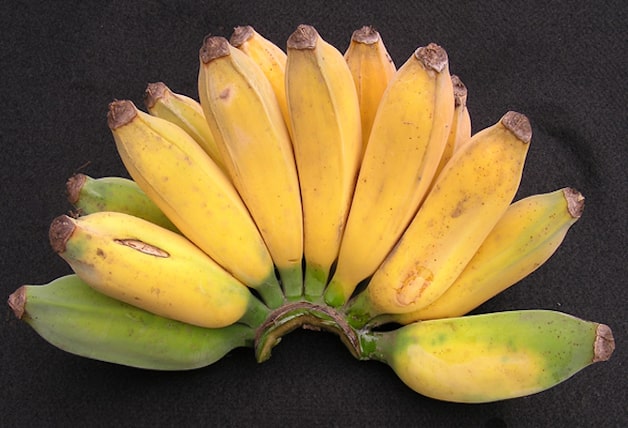Chicken Egg Banana - Cambodia National Fruit
Fruit Information

Beyond their nutritional value, bananas have profound economic and cultural significance in many regions, providing livelihoods for millions of smallholder farmers and workers in the global supply chain. The fruit plays important roles in traditional cuisines worldwide, from plantain-based dishes in Africa and Latin America to desserts and smoothies in Western cultures. Banana plants are remarkably versatile, with leaves used for food wrapping and cooking, fibers for textiles and paper production and organic matter for composting. Modern food processing has expanded banana applications to include chips, flour, purees and various functional food products, while traditional preparation methods continue to be valued for their cultural heritage and nutritional benefits.
| Fruit Name | Chicken Egg Banana |
| Scientific Name | Musa Acuminata |
| Country | Cambodia |
| Continent | Asia |
| Fruit Season | Year-round |
| Fruit Color | Yellow |
| Fruit Size | Small |
| Fruit Taste | Very Sweet |
| Fruit Origin Region | Southeast Asia |
| Designation Year | 1993 |
| Peak Month | All year |
| Economic Importance | Local Specialty |
| Cultural Use | Khmer cuisine, traditional offerings |
| Processing Type | Fresh, Desserts, Traditional sweets |
| Fruit Shape | Small oval |
| Texture | Creamy and Sweet |
| Nutritional Value | Potassium, Vitamin B6, Natural sugars |
| Storage Type | Room temperature |
| Harvest Method | Bunch cutting |
| Shelf Life | 2-3 days |
| Climate Type | Tropical |
| Soil Type | Rich alluvial |
| Water Requirement | High |
| Tree Height | 3-6 meters |
| Flowering Season | Continuous |
| Fruiting Age | 9-12 months |
| Yield Per Tree | 20-30 kg |
| Export Countries | Thailand, Vietnam, Cambodia |
| Import Countries | Regional markets |
| Medicinal Use | Energy, Digestive health |
| Festival Association | Khmer New Year, temple offerings |
| Historical Significance | Traditional Khmer variety |
| Alternative Names | Chek Pong Moan, Lady Finger |
Detailed Information
Cultivation & Origin
Banana cultivation has evolved from wild species like Musa acuminata and Musa balbisiana through thousands of years of human selection and breeding, resulting in the seedless, sweet varieties consumed today. The global banana industry is dominated by large-scale plantations in tropical regions including Ecuador, Philippines, Costa Rica, Guatemala and Colombia, with production systems ranging from small family farms to extensive commercial operations. Modern banana agriculture employs sophisticated techniques including tissue culture propagation, precision fertilization, disease management protocols and specialized harvesting and packaging systems to ensure consistent quality and global distribution.
Nutritional Benefits
From a nutritional perspective, bananas offer an impressive array of health benefits due to their rich mineral and vitamin content. The high potassium levels help regulate blood pressure and support cardiovascular health, while vitamin B6 aids in brain function and neurotransmitter synthesis. Bananas contain resistant starch, particularly in unripe fruit, which acts as a prebiotic, promoting beneficial gut bacteria growth and improving digestive health. The fruit also provides antioxidants like dopamine and catechins, which help combat oxidative stress and inflammation. The natural sugars in bananas - glucose, fructose and sucrose - provide immediate and sustained energy, making them popular among athletes and active individuals.
Economic & Agricultural Significance
The banana industry faces significant challenges including fungal diseases like Panama disease and Black Sigatoka, which threaten major commercial varieties like Cavendish bananas. Climate change impacts including changing rainfall patterns, increased temperatures and extreme weather events pose additional risks to production stability. Sustainable farming practices are increasingly adopted, including organic certification, fair trade programs and integrated pest management systems. Research focuses on developing disease-resistant varieties through conventional breeding and biotechnology, while also exploring wild banana species for genetic diversity that could enhance future crop resilience.
Cultural & Modern Applications
Beyond their nutritional value, bananas have profound economic and cultural significance in many regions, providing livelihoods for millions of smallholder farmers and workers in the global supply chain. The fruit plays important roles in traditional cuisines worldwide, from plantain-based dishes in Africa and Latin America to desserts and smoothies in Western cultures. Banana plants are remarkably versatile, with leaves used for food wrapping and cooking, fibers for textiles and paper production and organic matter for composting. Modern food processing has expanded banana applications to include chips, flour, purees and various functional food products, while traditional preparation methods continue to be valued for their cultural heritage and nutritional benefits.